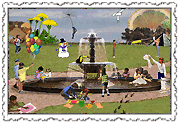

 |  |
Friction |
Experiment with friction
Vollis Simpson is an artist who creates kinetic sculptures and whirligigs. He uses bearings in all of his spinning pieces so that they move smoothly. The experiment below is a nice introduction to friction and bearings.
Vollis explains how he uses bearings.
(2MB)
|
Try experimenting with bearings.You'll need: |
Add balls of clay to ends of pencil.
Attach pencil to lid with clay.
Place lid on can. How well does it spin?
Remove lid and place marbles on can.
Replace the lid and spin again. What changed?
To find more helpful tidbits from teachers for understanding |
 |

|
What would happen if you used more or less marbles? What if you substituted ping pong balls for marbles? or BB's? Take a closer look a bicycle wheel - can you guess where the bearings are? Visit a local artist who creates kinetic sculptures or whirligigs. |
|

|
|
|
||
|
||
|
|
||
 Gathered by topic |
 Connected together |
 Index of ideas |
 Search |